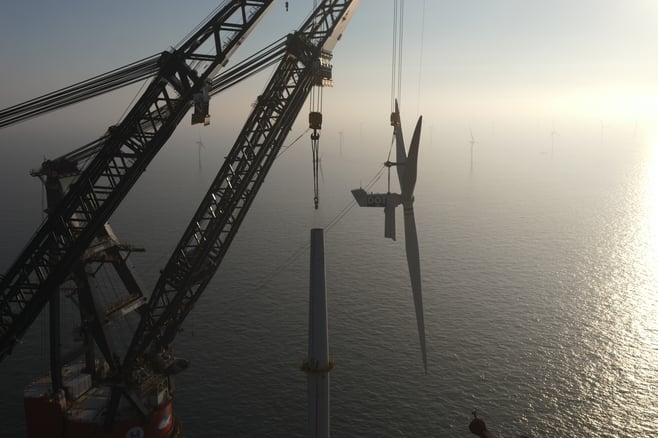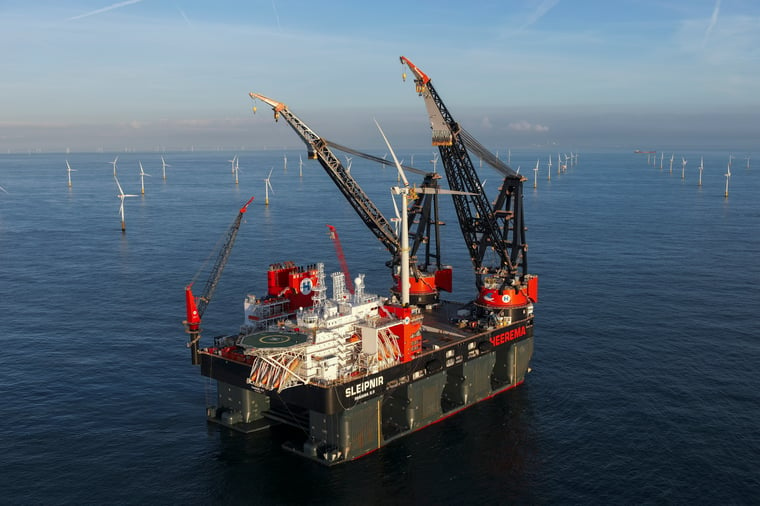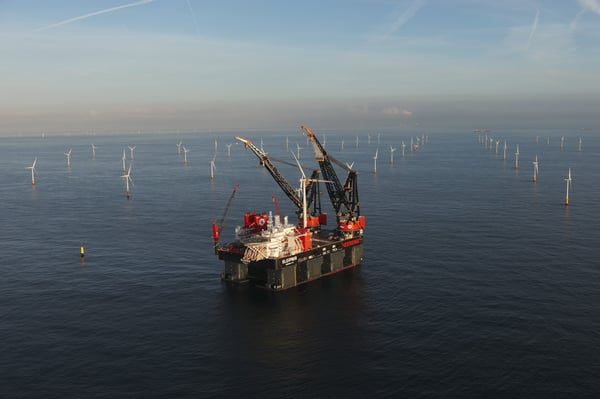Heerema Marine Contractors has tested its novel Rotor Nacelle Assembly (RNA) installation method offshore for the first time. Heerema performed the demonstration project in collaboration with DOT and the Delft University of Technology (TU Delft) to collect valuable operational data and test installation methods and durations.
Floating installation of wind turbine generators
The offshore wind industry is projected to produce 228 GW by 2030, enough to power over 68 million homes. To meet these targets, offshore wind turbines are progressively increasing in size and are being planned for installation in remote locations and deeper water depths. Due to these market developments, Heerema strategically developed the novel RNA method for the next generation of wind turbines.
The largest technical challenge when using a floating installation vessel is the relative motion between the vessel’s crane and the geostatic foundation of the offshore structure. One specific point of attention within the RNA method is the blade installation, which has been identified as the most critical part of the turbine installation offshore for any vessel. To combat these challenges, Heerema has developed the guided root end positioning tool, known as the GREPT. This in-house developed blade assembly tool enables offshore handling and installation of blades safely and efficiently.
The development of Heerema’s RNA method has been ongoing over the last two years and has been tested extensively within Heerema’s Leiden Office based Simulation Center. This offshore test put the method into practice for the first time in Eneco’s Prinses Amalia wind park, the Netherlands. The test results will be used to continue improving the RNA method within the Simulation Center.
Heerema’s CEO Koos-Jan van Brouwershaven said: ‘testing our novel RNA installation method offshore is a significant step forward in our ambition to deliver the solutions clients need for the next generation of offshore wind turbine generators. This project is another example of proving our methods offshore that have been developed in our Simulation Center.’
.jpg?width=658&name=DOB-DOT-Fox%20(1%20of%208).jpg) Heerema's GREPT in action
Heerema's GREPT in action
Slip Joint test
In addition to Heerema’s RNA installation project, the offshore scope included testing DOT’s Slip Joint connection. Generally, wind turbine generators use bolted flange-to-flange connections between the subsequent parts, installed offshore using multiple lifts. Whereas the Slip Joint is an alternative connection between an offshore wind turbine and its foundation. It works and looks like two paper cups upside down stacked on top of each other. The connection is based on friction, where the weight ensures a firm and stable connection. Installation is done by simply sliding the two-part over each other without the use of grout or bolts. This simple mechanism allows for cost reduction in material, equipment, and personnel as well as allowing for a shorter installation time.
Two separate Slip Joint connections were used during the FOX project: connecting the wind turbine’s lower tower to the monopile foundation and connecting the nacelle to the upper tower. Furthermore, a Slip Joint based seafastening was used to transport the complete tower section safely and to be able to transfer the load to the ship’s crane in a controlled and efficient manner.

During the offshore test, Heerema assembled the complete wind turbine generator onboard, which included the installation of blades using the GREPT. After that, the tower was installed on a pre-installed monopile using DOT’s slip joint connection. The single lift RNA was installed using a slip joint connection and also thereafter with a flange-to-flange connection. After the test project was finalized, the wind turbine generator was disassembled and the monopile removed using a Vibro Lifting Tool.
During operations, TU Delft researchers were onboard and successfully collected a unique data set consisting of over 15 million data points, gathered by over a dozen motion tracking sensors, specially designed for this purpose. This data will be analyzed by them to develop knowledge and validate methods for the installation of the next generation of offshore wind farms.
.jpg?width=658&name=DOB-DOT-FOX%20(11%20of%2020).jpg)
Vibro Lifting Tool testing
The monopile used was installed in 2018 as part of a previous test project known as SJOR. The SJOR project was the first time a Vibro Lifting Tool had been used with a dynamically positioned (DP) vessel for the installation of a monopile without the use of a gripper frame or similar. This time, the process was reversed to execute the removal of the monopile.
During removal, the test scope continued with extensive research undertaken in collaboration with Heerema Engineering Solutions and CAPE Holland. This action included a series of tests that were executed while reinstalling the monopile and again safely removing the structure before transferring it to Sleipnir’s deck. This testing delivers valuable data that can be used to demonstrate the feasibility of monopile installation without the need for gripper frames due to the capabilities of Heerema’s DP vessels and the Vibro Lifting Tool.
-6.jpg?width=658&name=DOB-DOT-FOX%20(1%20of%201)-6.jpg)
Research partnership
This demonstration project, known as FOX (Floating Offshore installation of XXL Wind Turbines), was a collaborative effort between Heerema, DOT, and TU Delft and was supported by the Dutch Ministry of Economic Affairs and Climate Policy and Eneco. The partners worked together with a wide range of subcontractors who have supported this test, including Heerema Engineering Solutions, F&B Group, Harco Heavy Lifting, Ampelmann, Sif, and CAPE Holland.
Read more about the TU Delft research scope here.


/People%20for%20job.jpg?width=600&name=People%20for%20job.jpg)